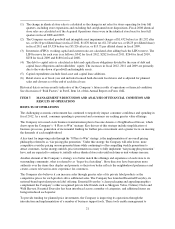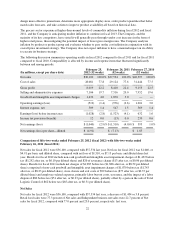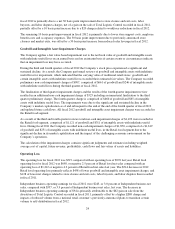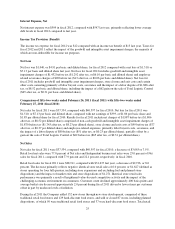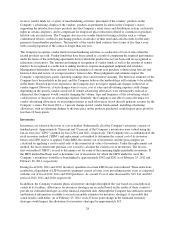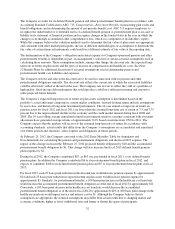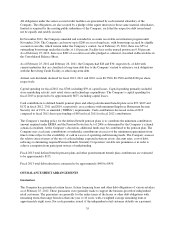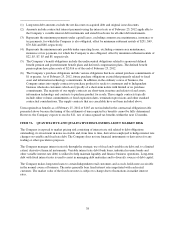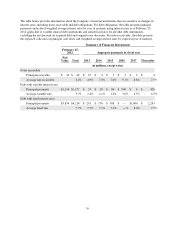Albertsons 2012 Annual Report Download - page 34
Download and view the complete annual report
Please find page 34 of the 2012 Albertsons annual report below. You can navigate through the pages in the report by either clicking on the pages listed below, or by using the keyword search tool below to find specific information within the annual report.based on the Company’s industry, capital structure and risk premiums including those reflected in the current
market capitalization. If management identifies the potential for impairment of goodwill, the fair value of the
implied goodwill is calculated as the difference between the fair value of the reporting unit and the fair value of
the underlying assets and liabilities, excluding goodwill. An impairment charge is recorded for any excess of the
carrying value over the implied fair value. Fair value calculations contain significant judgments and estimates
related to each reporting unit’s projected weighted average cost of capital, future revenue, profitability, cash
flows and fair values of assets and liabilities. When preparing these estimates, management considers each
reporting unit’s historical results, current operating trends and specific plans in place. These estimates are
impacted by variable factors including inflation, the general health of the economy and market competition. The
Company has sufficient current and historical information available to support its judgments and estimates.
However, if actual results are not consistent with the Company’s estimates, future operating results may be
materially impacted.
The Company also reviews intangible assets with indefinite useful lives, which primarily consist of trademarks
and tradenames, for impairment during the fourth quarter of each year, and also if events or changes in
circumstances indicate that the asset might be impaired. The reviews consist of comparing estimated fair value to
the carrying value. Fair values of the Company’s trademarks and tradenames are determined primarily by
discounting an assumed royalty value applied to projected future revenues associated with the tradename based
on management’s expectations of the current and future operating environment. The royalty cash flows are
discounted using rates based on the weighted average cost of capital and the specific risk profile of the
tradenames relative to the Company’s other assets. These estimates are impacted by variable factors including
inflation, the general health of the economy and market competition.
During the third and fourth quarters of fiscal 2012 the Company’s stock price experienced a significant and
sustained decline. As a result, the Company performed reviews of goodwill and intangible assets with indefinite
useful lives for impairment, which indicated that the carrying value of traditional retail stores’ goodwill and
certain intangible assets with indefinite useful lives exceeded their estimated fair values. The Company recorded
preliminary non-cash impairment charges of $907, comprised of $661 of goodwill and $246 of intangible assets
with indefinite useful lives during the third quarter of fiscal 2012.
The finalization of third quarter impairment charges and the results of the fourth quarter impairment review
resulted in an additional non-cash impairment charge of $525 including an immaterial finalization to the third
quarter preliminary charge. The fourth quarter charge is comprised of $460 of goodwill and $65 of intangible
assets with indefinite useful lives and was recorded in the Retail food segment. The impairment charge was due
to the significant and sustained decline in the Company’s market capitalization as of and subsequent to the end of
the fourth quarter of fiscal 2012 and updated discounted future cash flows. All fiscal 2012 goodwill and
intangible asset impairment charges were recorded in the Retail food segment.
As a result of the third and fourth quarter reviews, total non-cash impairment charges of $1,432 were recorded,
comprised of $1,121 of goodwill and $311 of intangible assets with indefinite useful lives. The calculation of the
impairment charges contains significant judgments and estimates including weighted average cost of capital,
future revenue, profitability, cash flows and fair values of assets and liabilities.
Rates used in fiscal 2012 to discount projected future cash flows, which varied for each reporting unit, ranged
between 10 percent and 15 percent. Perpetual growth rates, which also varied for each reporting unit, ranged
between 1 percent and 3 percent. Management performed sensitivity analyses on the fair values resulting from
the discounted cash flow analysis utilizing alternate assumptions that reflect reasonably possible changes to
future assumptions. For the Independent business and Hard discount reporting units, a 100 basis point increase in
the discount rate utilized in the discounted cash flow analysis would not have resulted in either reporting unit
failing the first step of the impairment tests. For the independent business and hard discount reporting units, a
100 basis point decrease in the estimated perpetual sales growth rates utilized in the discounted cash flow
analysis would not have resulted in either reporting unit failing the first step of the impairment tests. The fair
value of Independent business’ goodwill exceeded its $710 carrying value by 50 percent and the fair value of the
30



